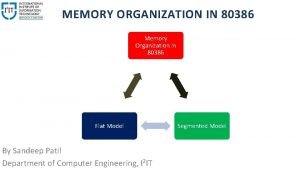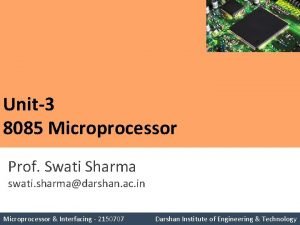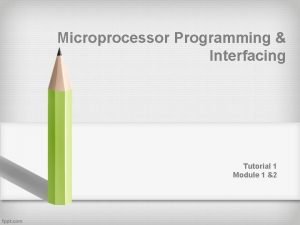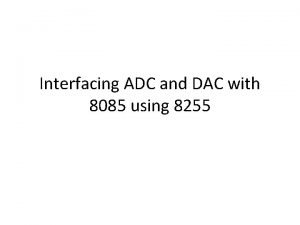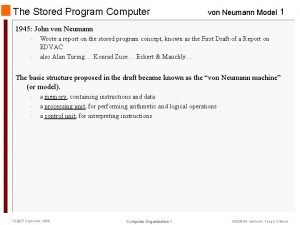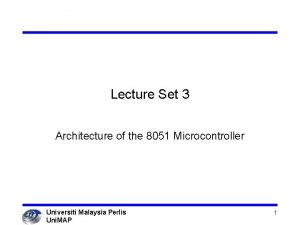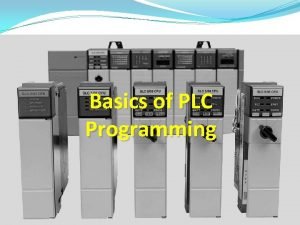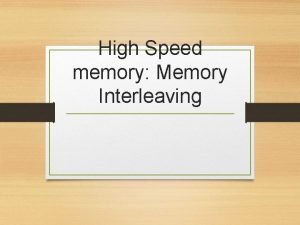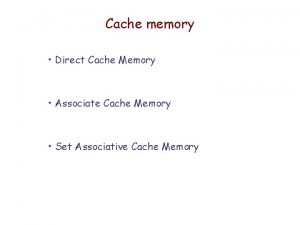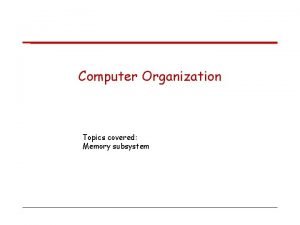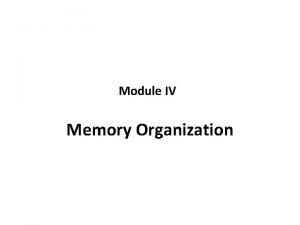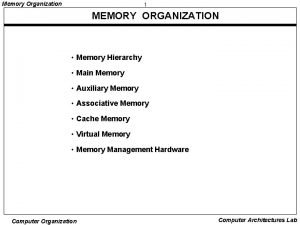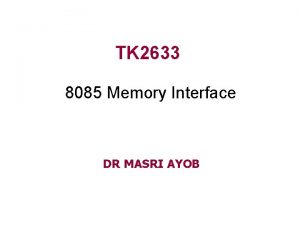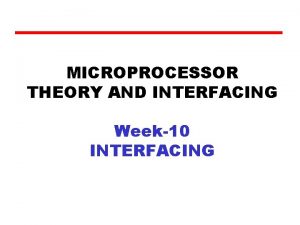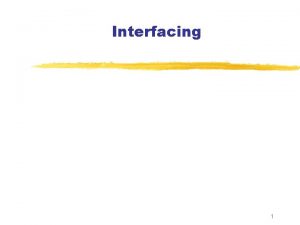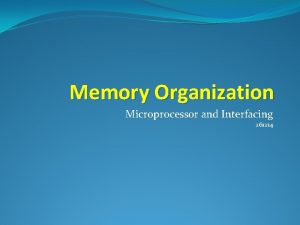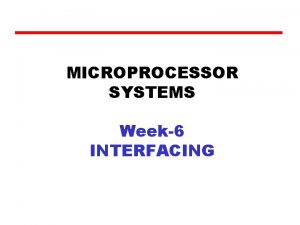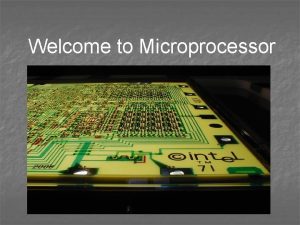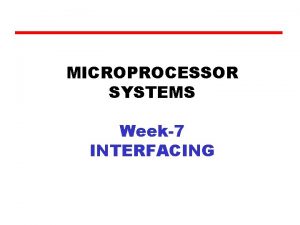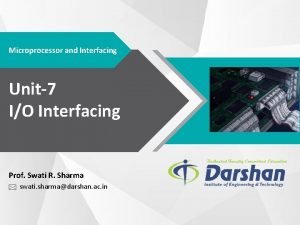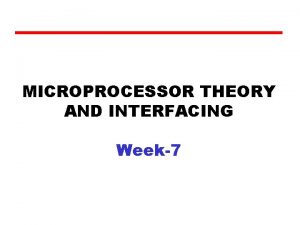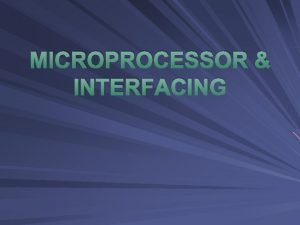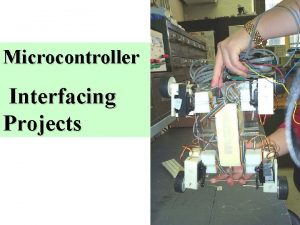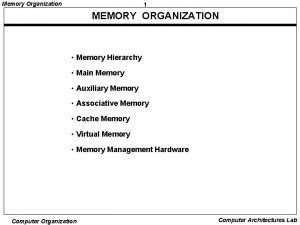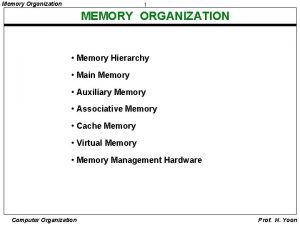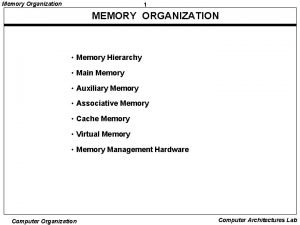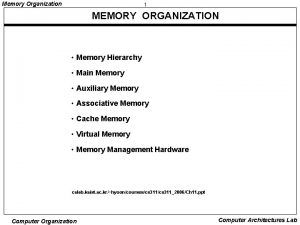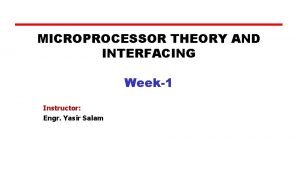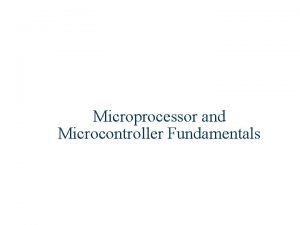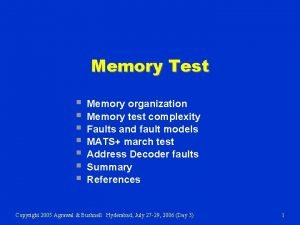MICROPROCESSOR THEORY AND INTERFACING Week8 INTERFACING Memory Organization





























- Slides: 29

MICROPROCESSOR THEORY AND INTERFACING Week-8 INTERFACING

Memory Organization of 8086 • 8086 has a 20 bit address bus and hence it can address 2^20 or 1, 048, 576 addresses • Each location one byte is stored • Two consecutive memory locations are required for a word to store • Both memory read and memory write operations require more than one machine cycle • Memory organization is required to complete memory read and memory write operations to be completed with one machine cycle

Memory Organization of 8086 • Memory is divided into two parts (banks) • Each bank will have 524, 288 bytes (512 KB) • One bank contains all the even addressed locations like 00000, 00002 and 00004 • Data lines of Even bank are connected to the lower eight data lines D 0 -D 7 • Even Bank also called lower bank

Memory Organization of 8086 • The other bank has all the odd addressed locations like 00001, 00003 and 00005 • Data lines of odd bank are connected to the upper eight data lines, D 8 - D 15 of the 8086 • ODD Bank also called higher bank

Memory Organization of 8086 • Address line A 0 is used as part of the enabling for memory in the lower bank. • Bus High Enable (BHE – Active Low) is used to enable the upper memory bank q EVEN (LOW) BANK q ODD (HIGH) BANK

Memory Organization (Data Transfer) • • • Case 1: Even address byte transfer by 8086 Read/Write a byte form/to an even address A 0 will be low BHE (Active Low) will be high Byte is transferred to/from low bank through D 0 -D 7 • One Machine Cycle required • Example MOV AH, DS: BYTE PTR[0000]

Memory Organization (Data Transfer) • Case 1: Even address byte transfer by 8086

Memory Organization (Data Transfer) • • Case 2: Odd address byte transfer by 8086 Read/Write a byte from/to an odd address A 0 will be high BHE (Active Low) will be asserted low Low bank is disabled and high bank is enabled Byte is transferred through D 0 -D 7 One Machine Cycle required Example MOV AL, DS: BYTE PTR[0001]

Memory Organization (Data Transfer) • Case 2: Odd address byte transfer by 8086

Memory Organization (Data Transfer) • Case 3: Even address word transfer by 8086 • A 0 will be asserted low – Low byte of the word through D 0 -D 7 • BHE (Active Low) will be asserted low –high byte of the word through D 8 -D 15 • One Machine Cycle required • Example MOV AX, DS: WORD PTR[0000]

Memory Organization (Data Transfer) • Case 3: Even address word transfer by 8086

Memory Organization (Data Transfer) • • Case 4: Odd address word transfer by 8086 Read/Write a word from/to an odd address Two bus cycles are required During the first machine cycle assert BHE (Active Low) as low and A 0 as high • First byte is transferred through D 0 -D 7 and the second byte is transferred through D 8 -D 15 • Example MOV AX, DS: WORD PTR[0001 H]

Memory Organization (Data Transfer) • Case 4: Odd address word transfer by 8086

Memory Organization (Data Transfer) Comparison among different memory accesses Memory Type Data Type BHE A 0 BUS Cycles Data Lines Even BYTE 1 0 1 D 0 – D 7 Odd BYTE 0 1 1 D 8 – D 15 Even WORD 0 0 1 D 0 – D 15 0 1 First D 8 – D 15 1 0 Second D 0 – D 7 Odd WORD

Memory Organization (Data Transfer) • Is the word at address 01231 H in a 8086 based system aligned or misaligned? • How many memory cycles are required to read the word?

Address Decoding Techniques • The Different types of address decoding techniques in 8086 Microprocessor are, 1. Absolute decoding 2. Linear decoding 3. Block decoding

Address Decoding Techniques 1. Absolute decoding • Memory chip is selected only for the specified logic level on the address lines • No other logic levels can select the chip

Address Decoding Techniques 1. Absolute decoding • Figure shows the memory interface with absolute decoding • Two 8 K EPROMs (2764) are used to provide even and odd memory banks • Control signals BHE and A 0 are used to enable outputs of odd and even memory banks respectively

Address Decoding Techniques 1. Absolute decoding • Each memory chip has 8 K memory locations, thirteen address lines are required to address each locations, independently • Remaining address lines are used to generate an unique chip select signal • This addressing technique is normally used in large, memory systems.

Address Decoding Techniques 2. Linear decoding • Hardware for the decoding logic can be eliminated, by using only required number of addressing lines (not all) • Other lines are simply ignored • Linear Decoding or Partial Decoding

Address Decoding Techniques 2. Linear decoding • Used in small systems • Figure shows the addressing of 16 K RAM (6264) with linear decoding • Control signals BHE and A 0 are used to, enable odd and even memory banks, respectively

Address Decoding Techniques 2. Linear decoding • RAM chips when A 19 is low, chip is selected • The status of A 14 to A 18 does not affect the chip selection logic • This gives you multiple addresses (shadow addresses) • This technique reduces the cost of Address Decoding Techniques in 8086 Microprocessor circuit, but it has drawback of multiple addresses

Address Decoding Techniques 3. Block decoding • In a microcomputer system the memory array is often consists of several blocks of memory chips • Each block of memory requires decoding circuit • To avoid separate decoding for each memory block special decoder IC is used to generate chip select signal for each block

Address Decoding Techniques 3. Block decoding • Figure shows the block Address Decoding Techniques in 8086 Microprocessor using 74138, 3: 8 decoder •

Memory Interfacing Example 1: Interface 32 KB of RAM to the 8086 microprocessor using absolute decoding with the suitable address.

Memory Interfacing

Memory Interfacing

Memory Interfacing

REVIEW
 Memory organization of 8086
Memory organization of 8086 Microprocessor and interfacing darshan pdf
Microprocessor and interfacing darshan pdf Microprocessor programming tutorial
Microprocessor programming tutorial Keyboard interfacing with 8085 using 8255
Keyboard interfacing with 8085 using 8255 What is memory interfacing
What is memory interfacing Microprocessor system with bus organization
Microprocessor system with bus organization Internal memory and external memory
Internal memory and external memory Primary memory and secondary memory
Primary memory and secondary memory Page fault
Page fault Neumann dst
Neumann dst Block organization essay- examples
Block organization essay- examples Episodic vs semantic memory
Episodic vs semantic memory Implicit explicit memory
Implicit explicit memory Long term memory vs short term memory
Long term memory vs short term memory Physical memory vs logical memory
Physical memory vs logical memory Which memory is the actual working memory?
Which memory is the actual working memory? Virtual memory in memory hierarchy consists of
Virtual memory in memory hierarchy consists of Eidetic memory vs iconic memory
Eidetic memory vs iconic memory Shared vs distributed memory
Shared vs distributed memory Internal memory organization of 8051 microcontroller
Internal memory organization of 8051 microcontroller Plc organization
Plc organization Interleaved and associative memory
Interleaved and associative memory Cache read operation flowchart
Cache read operation flowchart Cache memory organization
Cache memory organization Internal organization of memory chips
Internal organization of memory chips Memory organisation in computer architecture
Memory organisation in computer architecture Virtual memory organization
Virtual memory organization What is memory organization
What is memory organization Memory organization of 8085
Memory organization of 8085 Process organization in computer organization
Process organization in computer organization
